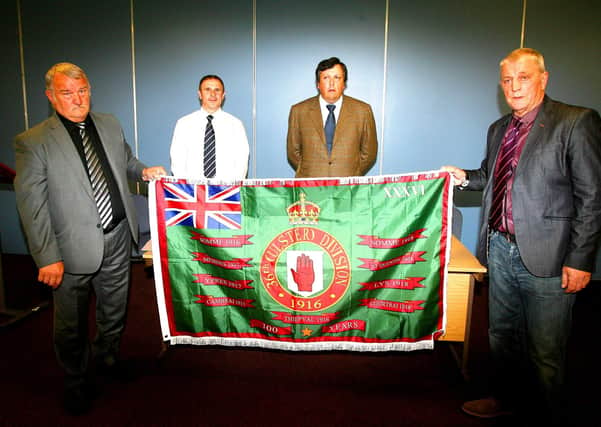Plan to replace loyalist terror flags with NI centenary ones


The move is the brainchild of the Loyalist Communities Council, which has brought together figures connected with the UDA, UVF and Red Hand Commando.
It echoes a similar plan in 2016, whereby a green-coloured flag honouring the 36th Ulster Division was created in time for the centenary of the Battle of the Somme.
Advertisement
Hide AdAdvertisement
Hide AdDuring that and other battles of the Great War, the division suffered 32,186 casualties, either killed, wounded, or missing in action.
At the time, UUP MLA Doug Beattie told the News Letter that the initiative had transformed Portadown and been “hugely successful”.
He said thanks to the adoption of the Somme flag in place of UVF or UDA ones, he was aware of only a dozen or so paramilitary flags in the town, where previously “you could have counted them in their fifties or hundreds”.
Now David Campbell, a former leading figure within the UUP who has in latter years worked with paramilitary-linked individuals in working-class loyalist communities, is hoping to repeat the success of the 2016 scheme in 2021.
Advertisement
Hide AdAdvertisement
Hide AdHe told the News Letter: “We’re working and will probably unveil shortly a Northern Ireland centenary flag, along the same idea as the centenary Somme flag, and hopefully replace paramilitary-type flags.
“We’re at the moment finalising a design, to have it ready shortly after Easter.
“We’ve talked about it for a while, with someone designing various options for us.
“We’re fairly close to having one ready to use. And hopefully it’ll be quite a good uptake, similar to the Somme flag.”
Advertisement
Hide AdAdvertisement
Hide AdAsked who would pay for the flags, Mr Campbell said they would “probably just collect for it,” or perhaps sell some of the flags to cover production costs.
“If you produce a reasonable number they’re not that expensive,” he said.
In terms of what the flags will look like, he said the Ulster banner is expected to be on it, and that “largely because of the current Brexit situation we are ensuring the idea of the Union is the centrepice of it”.
The island of Ireland had been part of the UK ever since the Act of Union, 1801.
Advertisement
Hide AdAdvertisement
Hide AdIt is hard to pinpoint exactly when Northern Ireland came into being as a new country.
But a key date isDecember 23, 1920, when the Government of Ireland Act was passed by the UK parliament.
It created two new assemblies: the Parliament of Northern Ireland, and the Parliament of Southern Ireland.
It entered effect on May 3, 1921, but the Irish War of Independence was ongoing at the time, and many Irish people did not recognise British sovereignty over any part of the island, much less the south.
Advertisement
Hide AdAdvertisement
Hide AdThe Anglo-Irish Treaty was signed on December 6, 1921, recognising the Irish Free State, though it was still part of the British Commonwealth (only leaving it in 1949).
A message from the Editor:
Thank you for reading this story on our website. While I have your attention, I also have an important request to make of you.
Advertisement
Hide AdAdvertisement
Hide AdWith the coronavirus lockdown having a major impact on many of our advertisers — and consequently the revenue we receive — we are more reliant than ever on you taking out a digital subscription.
Subscribe to newsletter.co.uk and enjoy unlimited access to the best Northern Ireland and UK news and information online and on our app. With a digital subscription, you can read more than 5 articles, see fewer ads, enjoy faster load times, and get access to exclusive newsletters and content.
Visit https://www.newsletter.co.uk/subscriptions now to sign up.
Our journalism costs money and we rely on advertising, print and digital revenues to help to support them. By supporting us, we are able to support you in providing trusted, fact-checked content for this website.
Alistair Bushe
Editor